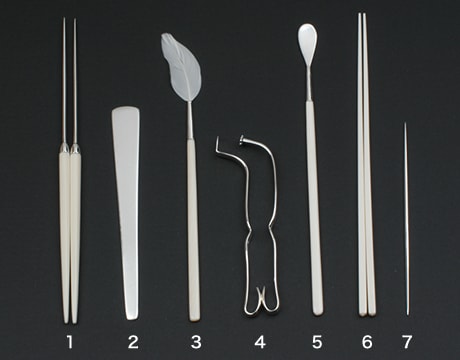
The Beauty of KODO
Basic Terms
Rikkoku Gomi
The target of KODO is agarwood, or aloeswood. Appreciating the subtle differences in the fragrance of aloeswood is said to be the ultimate art of Kodo. Rikkoku of Rikkoku Gomi, which is the basis for classifying and appreciating aromatic woods, classifies aromatic woods according to their quality: Kyara, Rakoku, Manaban, Manaka, Sasora, and Sumotara.
Gomi is a way of knowing the differences in fragrance according to taste (spicy, sweet, Acid, bitter, and salty). A single fragrant tree does not necessarily have only one flavor. Many aromatic woods have multiple tastes, and the strength or combination of Gomi can produce an indescribable aroma. The theory of five flavors was created in the 17th century to help people remember aromas. The following is a description of the six types.
However, although the Rikkoku and five tastes are defined, due to the nature of fragrant woods, there are subtle differences in fragrance even among the same kind of woods, and some woods have similar fragrances even if they come from different regions. Both nature and the human senses have subtle effects and are easily influenced.
Gomi (5 flavors)
- Spicy
- the fragrance of the spices
- Sweet
- like the sweetness of honey
- Acid
- Sour like plum
- Salty
- like salt that removes sweat.
- Bitter
- like bitter medicine
Rikkoku (Six countries)
The following is a list of some of the tastes of the styles of Rikkoku.
- Kyara
- The taste of Kyara is gentle and elegant, and its bitterness is elegant. It is naturally elegant and graceful, just like a courttier.
Place of origin: Vietnam, etc.
Taste = Spicy
- Rakoku
- When there is a smell of sandalwood, it is often accompanied by bitterness. It is like that of a warrior.
Place of origin ... Silla≒Siam≒Thailand
Taste = sweet.
Some other styles are spicy.
- Manaban
- The taste is mainly sweet, and it is a sign of Manaban to have a lot of oil in Ginyou, but there are other examples as well, and Manaban products are much more pleasant than Kyara and the rest of the products.
Place of origin ... Malabar Coast, southwest India.
Taste = salty
Some other styles are sweet.
- Manaka
- The smell is light and lustrous. It has a curved aroma, as if it were a woman with a grudge.
Place of origin: Malacca, southwest of the Malay Peninsula.
Taste = neutral
Some other styles are salty.
- Sumotara
- It is naturally acidic before and after, similar to Kyara, but thinner and lower in rank, and its quality, for example, is like that of an underground man wearing a crown.
Place of origin ... Sumatra
Taste = acid
- Sasora
- Sasora has a cool and sour smell, and when it is burned, it is so elegant that it sounds like Kyara.
However, it is naturally light and is replaced by a lingering fragrance. It is like a monk.
Place of origin … unknown
Taste = spicy
Some other styles are acid.
Fire tools
A general term for small tools used for fire preparation and incense burning.

(From left to right)
- 1 Koji
- Fire tongs, used to hold a charcoal pile or to make chopstick marks on the ashes.
- 2 Haioshi
- A tool used to push the ashes in the censer.
- 3 Habouki
- Made of feathers, used to remove ashes from the censer.
- 4 Ginyou-hasami
- A tool used to grip the mica plate called ginyou.
- 5 Kousaji
- Also called kousukui, used for scooping incense wood.
- 6 Kyouji
- Also called “incense chopsticks,” these chopsticks are used to grasp the fragrant wood.
- 7 Uguisu
- A needle used to hold the incense packet in place after burning incense.

